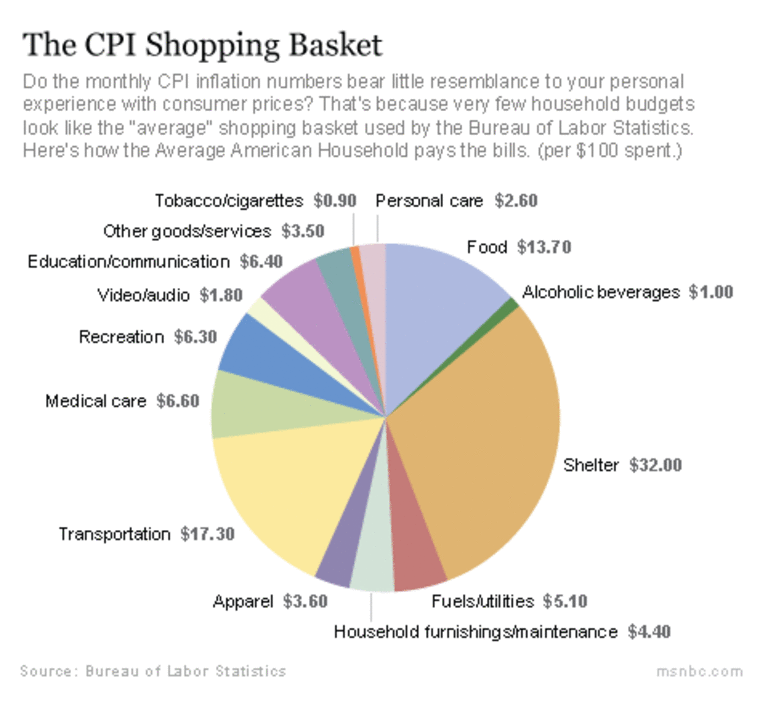Over the past year, the government index that tracks consumer prices has risen by 2.7 percent. That means your cost of living has risen by the same amount, right?
Not exactly. Unless you’re a very unusual shopper, changes in prices probably have had a much different impact on your budget than the government’s widely watched inflation barometer, the Consumer Price Index, would lead you to believe.
Like most national economic statistics, the CPI was created to take a high-level snapshot of conditions affecting the entire U.S. population. The CPI has a huge impact. Among other things, it’s used to determine cost of living increases for a variety of public and private wages and benefits as well as government disability and retirement programs, including Social Security.
But just as the median home price reflects the value of very, very few individual homes, the CPI is designed to produce a single data point that measures the monthly change in prices paid by a wide range of individuals. That’s the main reason your household budget doesn't track well with month-to-month changes in the CPI.
“The notion of an average consumer is an abstraction," said Jonathan Church, an economist who tracks prices at the Bureau of Labor Statistics' Office of Prices and Living Conditions. "Nobody goes out and buys 80,000 goods and services in 25,000 outlets, which is what we do.”
In fact, the BLS does not actually buy those items, but government workers do go shopping to figure out the prices, including sales tax. They take the resulting prices and crunch the numbers into more than 200 categories in eight major groups. Over time, as spending patterns change, the so-called basket gets tweaked.
Often one item may represent thousands in the category. BLS shoppers, for example, may use a 4.4-pound bag of golden delicious apples, extra-fancy grade, to represent the entire apples category. If you crave Cortlands, your personal apple inflation rate might be different.
While the BLS basket is structured to reflect the widest population, shopping habits vary widely depending on income and other factors. Wealthier households, for example, spend more on discretionary items like recreation or entertainment. Lower-income households spend a bigger portion of their weekly budget on gasoline and food, so they get hit much harder with price increases of those items.
A household with four teenage girls will feel the effect of changes in clothing prices much more heavily than a retired couple who has a full closet and no longer maintains an office wardrobe. On the other hand the retired couple will feel the effect of rising health care costs more acutely than most single people in their 20s.
Another reason the Consumer Price Index seems to misstate the "true" rate of inflation is because many economists focus on the so-called "core" CPI rate, which excludes volatile food and energy prices.
The "core" CPI is up only 1.2 percent over the past year, but many consumers rightly complain that figure understates the true inflation rate. But economists, including policymakers like Federal Reserve Chief Ben Bernanke, say the core rate gives a clearer picture of persistent inflation trends.
Nobody suggests that higher food and energy prices don’t matter, and their volatility has an outsized impact on consumer psychology. Simply put: People pay much more attention when prices are rising than when they're falling. Despite a recent, sharp run-up, the price of gasoline today is still lower that it was in the summer of 2008, when pump prices peaked at well over $4 a gallon.
“The price has gone down more than $2 since then and come up more than $1 since last November," said Michael Montgomery, a senior economist a HIS Global Insight. “But that dollar move since last November is the one people remember.”
Price hikes for food and energy also make us feel worse, say economists, because they’re among the most visible. As anyone who drives a car is painfully aware, few other products require that you stand and stare at the price, in giant lettering, for several minutes every time you consume the product. If you shop for food once a week, it’s hard not to notice when your favorite box of frozen pizza rings up 10 cents higher at the register than it did last week.
But the impact on your total budget is much less than, say, the money you may be saving the next time you buy a flat-panel TV. A $100 price break on a new 42-inch television will buy a lot of boxes of frozen pizza. The average television set in the BLS shopping basket costs 85 percent less than the one used in the calculation a decade ago.
Still, at least once a week, you’re entitled to grumble about how much more you're spending on pizza.
Many prices can be tough for the average shopper to track without the rigorous approach of the BLS. For example, you can ask your favorite consumer electronics retailer to shoot you an e-mail when a better deal comes along on that new tablet computer you have your eye on. But how many times have you bought the same piece of clothing twice within a year?
Quick: Since 2005, have clothing prices gone up or down?
Answer: Neither. They’ve barely budged.
